2021 TOYOTA PROACE CITY VERSO wipers
[x] Cancel search: wipersPage 185 of 272
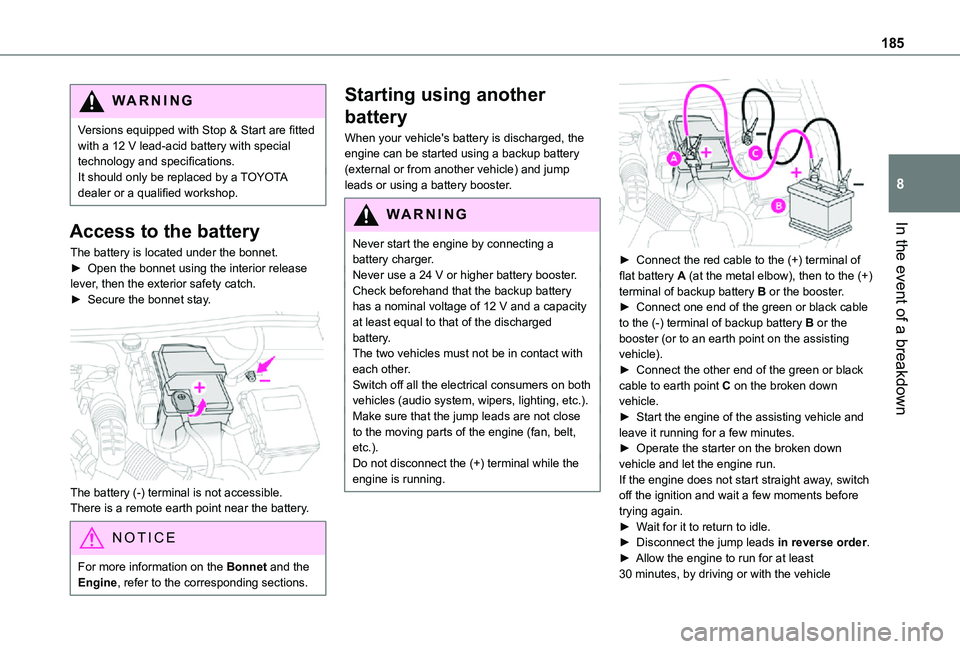
185
In the event of a breakdown
8
WARNI NG
Versions equipped with Stop & Start are fitted with a 12 V lead-acid battery with special technology and specifications.It should only be replaced by a TOYOTA dealer or a qualified workshop.
Access to the battery
The battery is located under the bonnet.► Open the bonnet using the interior release lever, then the exterior safety catch.► Secure the bonnet stay.
The battery (-) terminal is not accessible.There is a remote earth point near the battery.
NOTIC E
For more information on the Bonnet and the Engine, refer to the corresponding sections.
Starting using another
battery
When your vehicle's battery is discharged, the engine can be started using a backup battery (external or from another vehicle) and jump leads or using a battery booster.
WARNI NG
Never start the engine by connecting a battery charger.Never use a 24 V or higher battery booster.Check beforehand that the backup battery has a nominal voltage of 12 V and a capacity at least equal to that of the discharged battery.The two vehicles must not be in contact with each other.Switch off all the electrical consumers on both vehicles (audio system, wipers, lighting, etc.).Make sure that the jump leads are not close to the moving parts of the engine (fan, belt, etc.).Do not disconnect the (+) terminal while the engine is running.
► Connect the red cable to the (+) terminal of flat battery A (at the metal elbow), then to the (+) terminal of backup battery B or the booster.► Connect one end of the green or black cable to the (-) terminal of backup battery B or the booster (or to an earth point on the assisting vehicle).► Connect the other end of the green or black cable to earth point C on the broken down vehicle.► Start the engine of the assisting vehicle and leave it running for a few minutes.► Operate the starter on the broken down vehicle and let the engine run.If the engine does not start straight away, switch off the ignition and wait a few moments before trying again.► Wait for it to return to idle.► Disconnect the jump leads in reverse order.► Allow the engine to run for at least 30 minutes, by driving or with the vehicle
Page 186 of 272
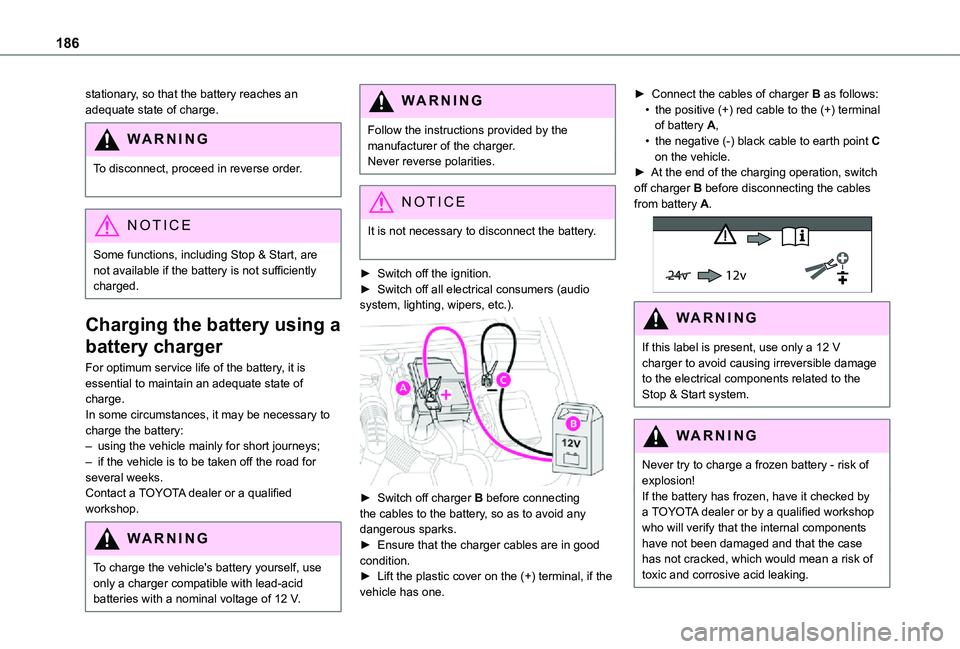
186
stationary, so that the battery reaches an adequate state of charge.
WARNI NG
To disconnect, proceed in reverse order.
NOTIC E
Some functions, including Stop & Start, are not available if the battery is not sufficiently charged.
Charging the battery using a
battery charger
For optimum service life of the battery, it is essential to maintain an adequate state of charge.In some circumstances, it may be necessary to charge the battery:– using the vehicle mainly for short journeys;– if the vehicle is to be taken off the road for several weeks.Contact a TOYOTA dealer or a qualified workshop.
WARNI NG
To charge the vehicle's battery yourself, use only a charger compatible with lead-acid batteries with a nominal voltage of 12 V.
WARNI NG
Follow the instructions provided by the manufacturer of the charger.Never reverse polarities.
NOTIC E
It is not necessary to disconnect the battery.
► Switch off the ignition.► Switch off all electrical consumers (audio system, lighting, wipers, etc.).
► Switch off charger B before connecting the cables to the battery, so as to avoid any dangerous sparks.
► Ensure that the charger cables are in good condition.► Lift the plastic cover on the (+) terminal, if the vehicle has one.
► Connect the cables of charger B as follows:• the positive (+) red cable to the (+) terminal of battery A,• the negative (-) black cable to earth point C on the vehicle.► At the end of the charging operation, switch off charger B before disconnecting the cables from battery A.
24v 12v
WARNI NG
If this label is present, use only a 12 V charger to avoid causing irreversible damage to the electrical components related to the Stop & Start system.
WARNI NG
Never try to charge a frozen battery - risk of explosion!If the battery has frozen, have it checked by a TOYOTA dealer or by a qualified workshop who will verify that the internal components have not been damaged and that the case has not cracked, which would mean a risk of toxic and corrosive acid leaking.
Page 187 of 272
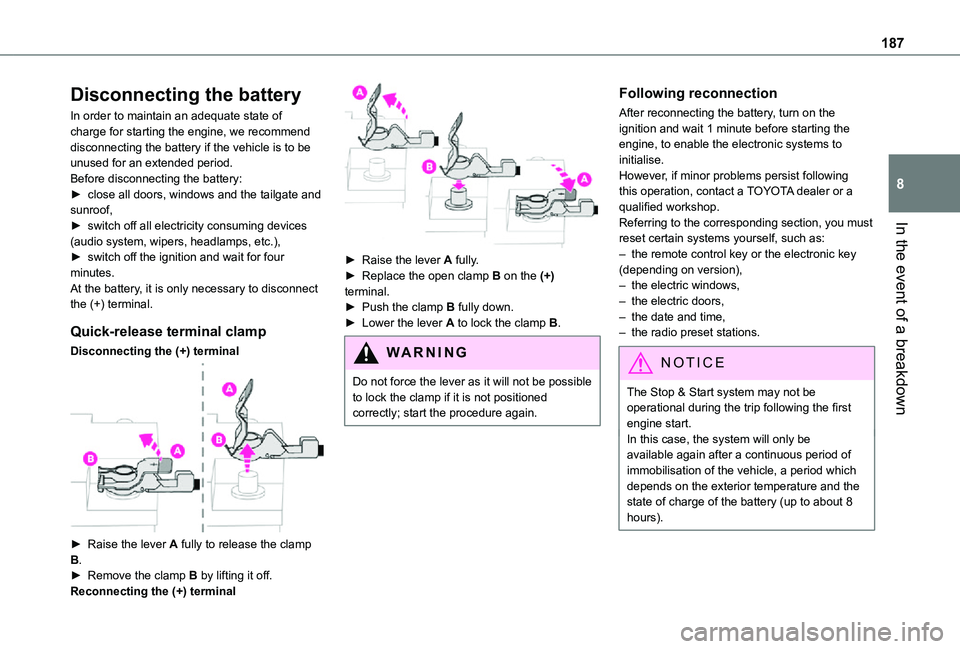
187
In the event of a breakdown
8
Disconnecting the battery
In order to maintain an adequate state of charge for starting the engine, we recommend disconnecting the battery if the vehicle is to be unused for an extended period.Before disconnecting the battery:► close all doors, windows and the tailgate and sunroof,► switch off all electricity consuming devices (audio system, wipers, headlamps, etc.),► switch off the ignition and wait for four minutes.At the battery, it is only necessary to disconnect the (+) terminal.
Quick-release terminal clamp
Disconnecting the (+) terminal
► Raise the lever A fully to release the clamp B.► Remove the clamp B by lifting it off.Reconnecting the (+) terminal
► Raise the lever A fully.► Replace the open clamp B on the (+) terminal.► Push the clamp B fully down.► Lower the lever A to lock the clamp B.
WARNI NG
Do not force the lever as it will not be possible to lock the clamp if it is not positioned correctly; start the procedure again.
Following reconnection
After reconnecting the battery, turn on the ignition and wait 1 minute before starting the engine, to enable the electronic systems to initialise.However, if minor problems persist following this operation, contact a TOYOTA dealer or a qualified workshop.Referring to the corresponding section, you must reset certain systems yourself, such as:– the remote control key or the electronic key (depending on version),– the electric windows,– the electric doors,– the date and time,– the radio preset stations.
NOTIC E
The Stop & Start system may not be operational during the trip following the first engine start.In this case, the system will only be
available again after a continuous period of immobilisation of the vehicle, a period which depends on the exterior temperature and the state of charge of the battery (up to about 8 hours).
Page 251 of 272
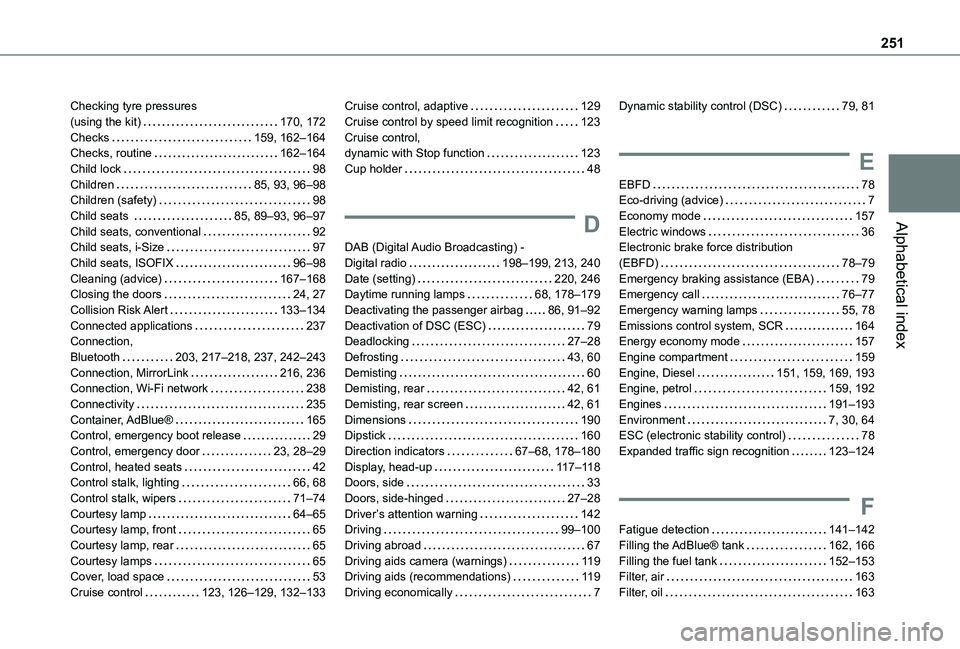
251
Alphabetical index
Checking tyre pressures (using the kit) 170, 172Checks 159, 162–164Checks, routine 162–164Child lock 98Children 85, 93, 96–98Children (safety) 98Child seats 85, 89–93, 96–97Child seats, conventional 92Child seats, i-Size 97Child seats, ISOFIX 96–98Cleaning (advice) 167–168Closing the doors 24, 27Collision Risk Alert 133–134Connected applications 237Connection, Bluetooth 203, 217–218, 237, 242–243Connection, MirrorLink 216, 236Connection, Wi-Fi network 238Connectivity 235Container, AdBlue® 165Control, emergency boot release 29
Control, emergency door 23, 28–29Control, heated seats 42Control stalk, lighting 66, 68Control stalk, wipers 71–74Courtesy lamp 64–65Courtesy lamp, front 65Courtesy lamp, rear 65Courtesy lamps 65Cover, load space 53Cruise control 123, 126–129, 132–133
Cruise control, adaptive 129Cruise control by speed limit recognition 123Cruise control, dynamic with Stop function 123Cup holder 48
D
DAB (Digital Audio Broadcasting) - Digital radio 198–199, 213, 240Date (setting) 220, 246Daytime running lamps 68, 178–179Deactivating the passenger airbag 86, 91–92Deactivation of DSC (ESC) 79Deadlocking 27–28Defrosting 43, 60Demisting 60Demisting, rear 42, 61Demisting, rear screen 42, 61Dimensions 190Dipstick 160
Direction indicators 67–68, 178–180Display, head-up 11 7–11 8Doors, side 33Doors, side-hinged 27–28Driver’s attention warning 142Driving 99–100Driving abroad 67Driving aids camera (warnings) 11 9Driving aids (recommendations) 11 9Driving economically 7
Dynamic stability control (DSC) 79, 81
E
EBFD 78Eco-driving (advice) 7Economy mode 157Electric windows 36Electronic brake force distribution (EBFD) 78–79Emergency braking assistance (EBA) 79Emergency call 76–77Emergency warning lamps 55, 78Emissions control system, SCR 164Energy economy mode 157Engine compartment 159Engine, Diesel 151, 159, 169, 193Engine, petrol 159, 192Engines 191–193Environment 7, 30, 64ESC (electronic stability control) 78
Expanded traffic sign recognition 123–124
F
Fatigue detection 141–142Filling the AdBlue® tank 162, 166Filling the fuel tank 152–153Filter, air 163Filter, oil 163
Page 255 of 272
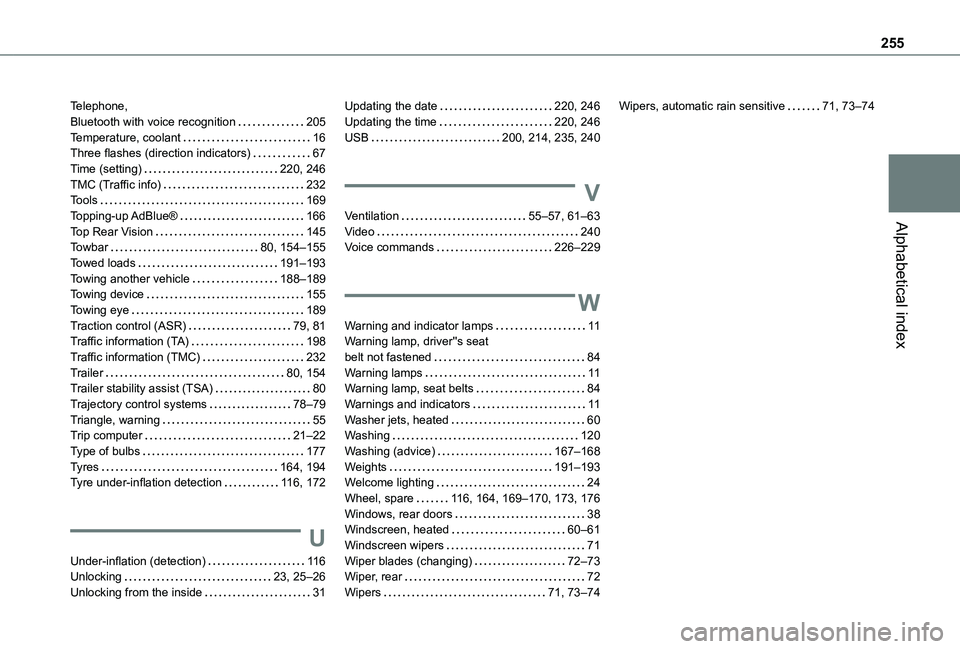
255
Alphabetical index
Telephone, Bluetooth with voice recognition 205Temperature, coolant 16Three flashes (direction indicators) 67Time (setting) 220, 246TMC (Traffic info) 232Tools 169Topping-up AdBlue® 166Top Rear Vision 145Towbar 80, 154–155Towed loads 191–193Towing another vehicle 188–189Towing device 155Towing eye 189Traction control (ASR) 79, 81Traffic information (TA) 198Traffic information (TMC) 232Trailer 80, 154Trailer stability assist (TSA) 80Trajectory control systems 78–79Triangle, warning 55Trip computer 21–22
Type of bulbs 177Tyres 164, 194Tyre under-inflation detection 11 6, 172
U
Under-inflation (detection) 11 6Unlocking 23, 25–26Unlocking from the inside 31
Updating the date 220, 246Updating the time 220, 246USB 200, 214, 235, 240
V
Ventilation 55–57, 61–63Video 240Voice commands 226–229
W
Warning and indicator lamps 11Warning lamp, driver''s seat belt not fastened 84Warning lamps 11Warning lamp, seat belts 84Warnings and indicators 11Washer jets, heated 60Washing 120
Washing (advice) 167–168Weights 191–193Welcome lighting 24Wheel, spare 11 6, 164, 169–170, 173, 176Windows, rear doors 38Windscreen, heated 60–61Windscreen wipers 71Wiper blades (changing) 72–73Wiper, rear 72Wipers 71, 73–74
Wipers, automatic rain sensitive 71, 73–74